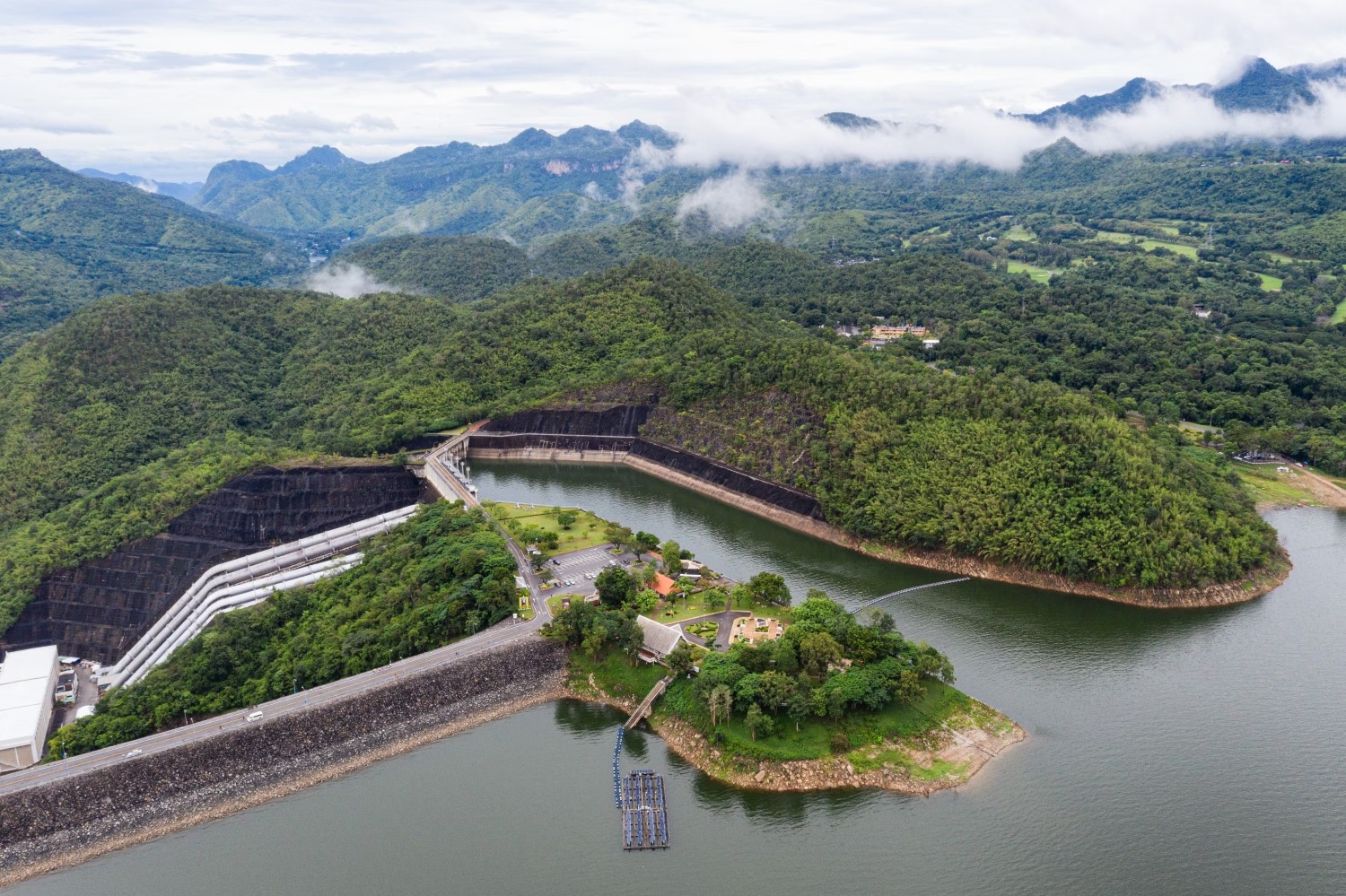Ratchaprapha Dam – also known as Cheow Lan Dam – is a majestic hydropower dam nestled within Khao Sok National Park in Surat Thani province, southern Thailand. The dam’s reservoir, Cheow Lan Lake, spans a vast emerald expanse dotted with soaring limestone karst cliffs and encircled by ancient rainforest. Often nicknamed the “Guilin of Thailand” for its dramatic scenery, this man-made lake has become a bucket-list destination for nature lovers and adventure travelers. Beyond its beauty, Ratchaprapha Dam plays a vital role in the region’s energy, water management, and ecology – a true example of a multi-purpose infrastructure shaping both the landscape and livelihoods.
🎖️ Must Try Tour
- Location5
- Amenities5
- Services5
- Price4.75
- Rooms4.5
Construction and History of Ratchaprapha Dam
Planning for Ratchaprapha Dam began in the late 1970s as Thailand sought to harness the Phra Saeng (Khlong Saeng) River for economic development. Construction commenced on February 9, 1982, and the earthen rockfill dam with a clay core was completed by September 1987. In a ceremonial inauguration on September 30, 1987, King Bhumibol Adulyadej bestowed the name “Rajjaprabha,” meaning “Light of the Kingdom,” upon the dam. This name signifies the optimism that the project would illuminate (literally and figuratively) the fortunes of Thailand’s south.
Dam Features at a Glance: Ratchaprapha is an impressive structure – an embankment dam rising 94 m high and stretching 761 m across the valley. Behind it lies a huge reservoir (Cheow Lan Lake) covering approximately 185 km² at full capacity. The lake can hold about 5.64 billion cubic meters of water. The dam’s hydroelectric power station houses three turbine generators of 80 MW each (total installed capacity 240 MW). This output is significant – the electricity generated by Ratchaprapha powers not only Surat Thani but also neighboring provinces throughout southern Thailand. In fact, soon after its completion, the dam became crucial in stabilizing the region’s power supply and supporting Thailand’s growing energy needs.
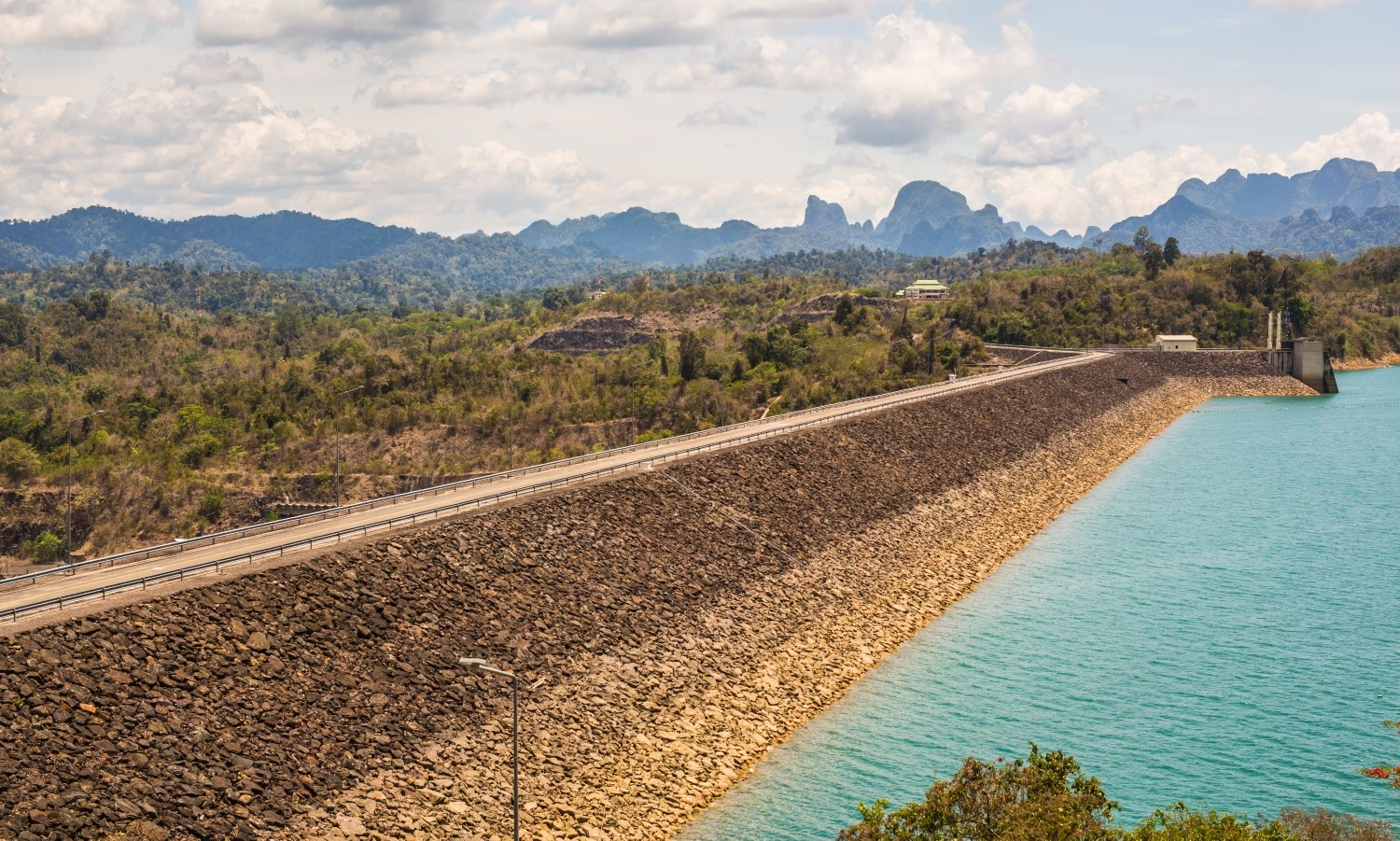
Historical Footnote: Ratchaprapha Dam was constructed by the Electricity Generating Authority of Thailand (EGAT) as part of Thailand’s 4th National Economic and Social Development Plan. Notably, Khao Sok National Park was only established in 1980, just two years before the dam project began. To enable the reservoir, the park’s boundaries were adjusted in 1982 to allow flooding of a large forested area. The dam’s completion in 1987 flooded the valley upstream over a period of about three years, giving birth to Cheow Lan Lake (also called Ratchaprapha Reservoir) and transforming the landscape forever.
What Lies Beneath Cheow Lan Lake
Mist hangs over the flooded forest of Cheow Lan Lake, with leafless tree trunks still standing where a valley once existed. Ratchaprapha Dam’s reservoir submerged vast tracts of old-growth rainforest, leaving only the tops of trees poking above the water’s surface.
Beneath the tranquil green waters of Cheow Lan Lake lies the hidden story of a lost valley. Before the dam, a small rural village and expanses of lowland rainforest occupied this area. When the reservoir was filled, the entire village was completely submerged – homes, farms, and forests disappearing under tens of meters of water. The Thai government provided the displaced villagers with land on higher ground nearby as compensation. Many of those original residents later found a new way of life tied to the lake: they became the pioneers of floating bungalows and raft houses, returning to live and work on the water by hosting tourists in this unique environment.
Remnants of the old landscape are still evident. Jagged limestone peaks that rise above the lake are merely the tips of larger mountains hidden below the surface. In shallow areas, one can spot bare tree trunks and branches protruding from the water – these are the tops of tall trees that once stood on hillsides, now eerie silhouettes in the lake. The flooded forest ecosystem has, over time, become a habitat for fish and other aquatic life, but it also serves as a poignant reminder of the rainforest that was sacrificed to create the dam.
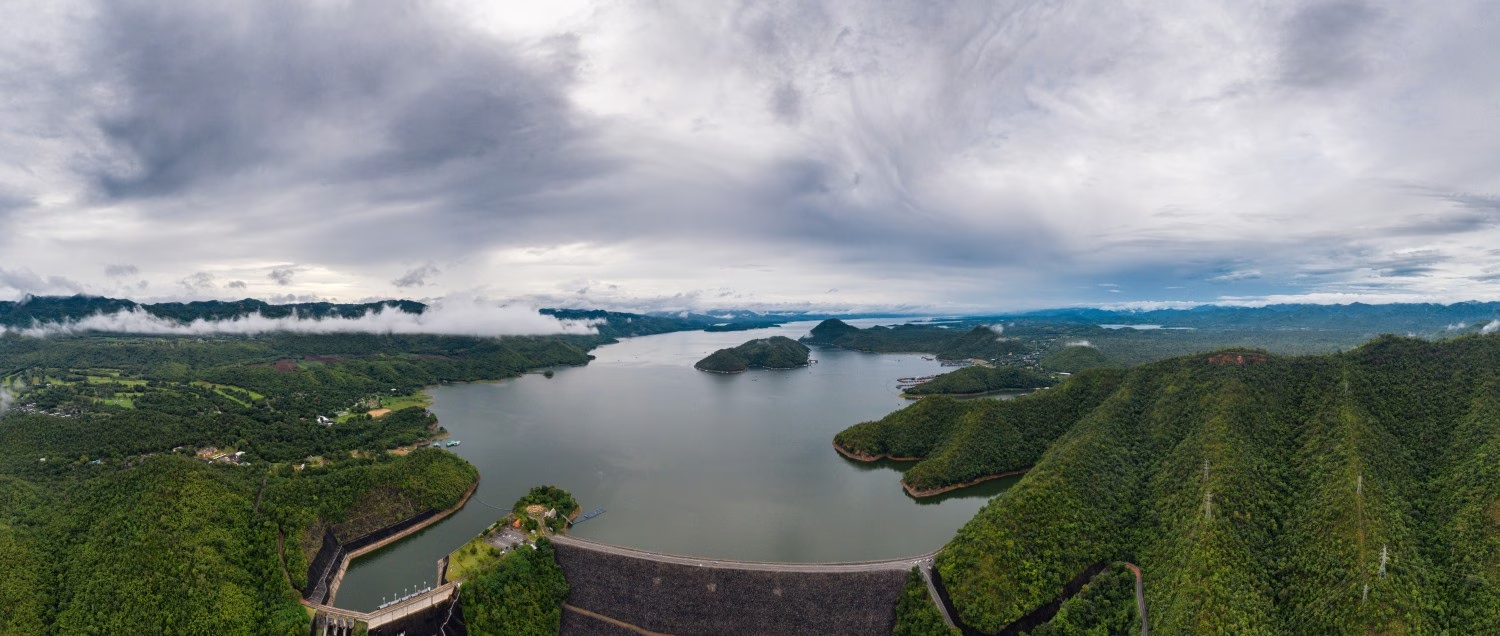
Purpose and Benefits of the Dam
Ratchaprapha was conceived as a multi-purpose dam project from the start. Its core purposes include:
Hydroelectric Power Generation: The dam’s primary role is to generate electricity for southern Thailand. With 240 MW capacity, it produces hundreds of millions kilowatt-hours of renewable power annually, significantly reducing reliance on fossil fuels. By lighting up cities and towns across Surat Thani and beyond, Ratchaprapha truly lives up to its name, “Light of the Kingdom.”
Irrigation for Agriculture: The reservoir is a crucial water source for irrigation in the province. Stored water is released in the dry season to feed canals and farmlands, sustaining rice paddies, fruit orchards, and rubber plantations in the lowlands. By providing water for agriculture year-round, the dam has enabled more stable harvests and farming incomes.
Flood Control: Before the dam, the Phra Saeng River was prone to seasonal flooding that could inundate villages and cropland. Ratchaprapha Dam helps regulate river flow – holding back excessive rain runoff during the monsoon and then gradually releasing it. This moderation of water flow has greatly reduced flood risks downstream in Surat Thani, protecting communities from what used to be frequent flood damage.
Fisheries and Food Supply: The dam created new opportunities for inland fisheries. The vast lake is teeming with fish; local fishermen catch species like tilapia, catfish, and snakeheads which thrive in the reservoir. In fact, fishing became one purpose of the dam, both for local livelihoods and provincial food supply. (Notably, the lake is also home to some rare species – for example, the Asian arowana fish, an endangered “living fossil,” has one of its last natural habitats in the waters by Ratchaprapha Dam.)
It’s worth emphasizing how significant the Ratchaprapha Dam is to southern Thailand’s development. By providing power, water, and flood safety, the dam has been a driver for economic growth in the region over the past few decades. The once remote jungle area now lights up villages and farms, and supports industries from agriculture to tourism. In many ways, Ratchaprapha became the lifeline that transformed Surat Thani into a more prosperous province.
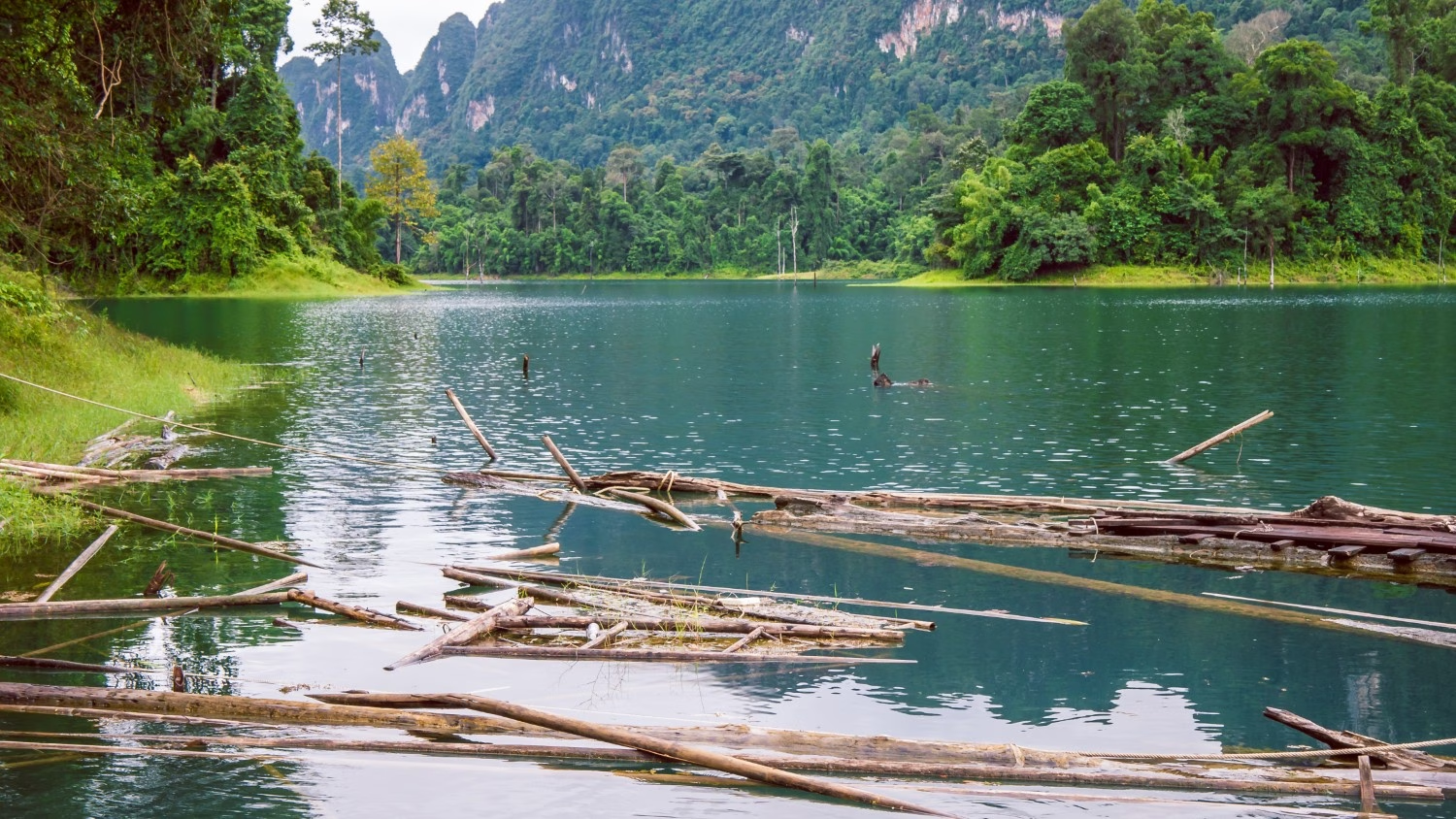
Environmental Impact and Wildlife Conservation
While the dam brought benefits, it also had profound environmental impacts on the Khao Sok ecosystem. The creation of the reservoir flooded a large swath of virgin rainforest that was part of a national park, an event that inevitably disrupted local flora and fauna. Recognizing the threat, authorities undertook a massive wildlife rescue operation in the mid-1980s: over 1,300 wild animals – birds, mammals, and reptiles – were captured and relocated to surrounding forests before the waters rose. Tragically, despite best efforts, a majority of these stressed animals did not survive the relocation process. The flooding of their habitat and the difficulty of transplanting entire ecological communities led to heavy wildlife losses that have been described as a major blow to the area’s biodiversity.
Aquatic life also went through drastic changes. As the riverine environment transformed into a stagnant lake, some species could not adapt. A 1995 study revealed that around 52 species of fish native to the original river essentially vanished after the dam’s introduction – they could not survive in the reservoir’s deeper, low-oxygen waters. The ecosystem shifted to favor lake-adapted species, altering the food chain and fishing patterns for local communities.
Moreover, the dam’s long-term impact on forest habitat fragmentation is now evident. The reservoir inundated low valleys and left remaining hilltops as isolated islands of forest within the lake. Over the decades, researchers observed declines in certain wildlife populations. Notably, a 2018 ecological study found the dam had caused a “collapse” of rainforest bird populations in the area. Many bird species that once ranged freely across the continuous forest were confined to small island fragments, leading to local extinctions of at least five bird species and greatly reduced diversity overall. The birds that persisted were mostly a few resilient species that could cope with degraded edge habitats, while more specialized rainforest birds vanished when their habitat was flooded and fragmented. Such findings highlight the sobering environmental cost of Ratchaprapha Dam – a reminder that even “green” hydropower projects can have significant biodiversity trade-offs.
On a positive note, conservation measures are in place to protect what remains of the ecosystem. Much of Cheow Lan Lake and its surrounding forests fall under the protection of Khao Sok National Park and adjacent wildlife sanctuaries. Park authorities strictly regulate land use around the reservoir – the steep forested slopes are largely untouched, allowing gibbons, hornbills, macaques, and even the occasional elephant to continue roaming the remaining habitat. Fishing in the lake is managed and limited to sustain fish stocks. By charging park entry fees (as described later) and enforcing wildlife laws, Thailand aims to ensure that Ratchaprapha’s environment and wildlife are conserved as much as possible alongside human use.
Tourism and Floating Bungalows on the Lake
From an unintended consequence to a major attraction – Cheow Lan Lake has blossomed into a premier ecotourism destination in Thailand. In the decades since its formation, the reservoir’s stunning scenery and unique floating lodges have drawn ever-increasing crowds of visitors. Today, over 70,000 tourists visit Ratchaprapha Dam and Cheow Lan Lake each year, making it one of the top nature tourism sites in the country. The combination of jade-green waters, towering karst cliffs, and misty rainforests creates a magical setting for outdoor adventure and relaxation.
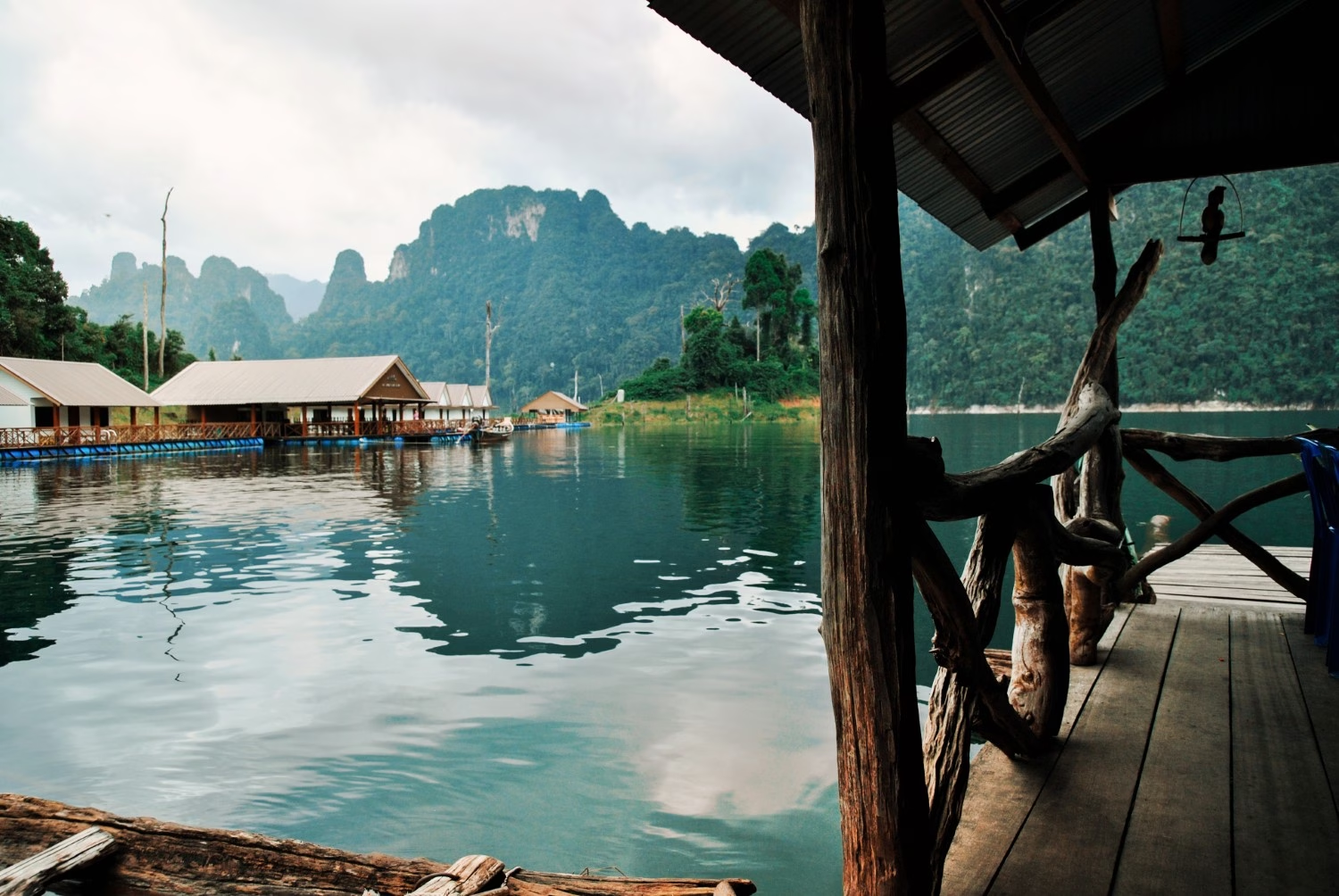
Panoramic daytime view of Cheow Lan Lake (Ratchaprapha Dam Reservoir) with its calm turquoise waters and towering limestone mountains. The breathtaking “Guilin of Thailand” scenery now attracts tens of thousands of visitors annually.
One of the most distinctive tourist experiences here is staying in floating bungalows on the lake. After the dam’s construction, local families were the first to build simple raft houses, and over time these evolved into a range of accommodations – from basic bamboo huts to upscale floating resorts. These raft house lodgings, operated by both Khao Sok National Park and private companies, allow visitors to sleep atop the water surrounded by nature. Waking up to the calls of gibbons echoing over the lake and watching dawn mist drift among the cliffs is an unforgettable experience for many. (Electricity at the raft houses is typically generator-supplied for a few hours in the evening, preserving the tranquil off-grid ambiance.)
Tour activities on Cheow Lan Lake abound. Long-tail boat tours are the most popular way to explore – local guides take tourists skimming across the water to see iconic spots like the trio of pinnacles at Khao Sam Klur (often called the “Three Friends” or “Three Brothers” rocks). These boat excursions offer close-up views of the steep limestone karsts rising from the lake, some nearly 1,000 m high and draped in lush greenery. Many tours include a trek into the jungle to visit hidden waterfalls or caves; a favorite is the journey to Nam Talu Cave, which involves a hike and sometimes wading through water to explore a cavern system rich with stalactites and wildlife. Kayaking and paddle-boarding on the calm lake waters are also serene ways to appreciate the surroundings – paddlers often spot wildlife like hornbills flying between the trees or dusky langur monkeys on the shore.
At the dam itself, viewpoints and facilities have been developed for visitors. The dam crest is open to the public and provides a sweeping panoramic view of the lake on one side and the lush valley downstream on the other. It’s a popular spot for photography, especially at sunrise or sunset when the light paints the lake and mountains in brilliant colors. The EGAT management of Ratchaprapha Dam even established a small park area with landscaped gardens and a few amenities: there’s a visitor guesthouse and the “Guilin Restaurant” overlooking the lake, as well as an 18-hole golf course near the dam site for those who fancy a round in a dramatic natural setting. While the golf course might seem surprisingly deep in a national park, it underscores how the dam area has been adapted to multi-use, including recreation.
Tourism on Cheow Lan Lake is generally well-managed to balance enjoyment with conservation. Most visitors come via package tours operated out of nearby towns (like Khao Sok Village or Surat Thani), which include the mandatory national park guide services. The number of overnight bungalows is capped by park regulations, and certain sensitive zones of the lake are off-limits to tourism to serve as wildlife refuges. Importantly, all tourists must pay national park entrance fees that contribute to conservation – as of May 2024 these fees were increased to 300 Baht for foreign adults (150 Baht for children) to support environmental protection efforts. Thai citizens pay a lower local rate in line with national park policies. These fees help fund ranger patrols, wildlife monitoring, and habitat restoration in Khao Sok National Park, ensuring that the natural beauty of Ratchaprapha can be enjoyed sustainably for generations to come.
Visitors are drawn year-round, as each season offers a unique charm. The dry season (November–April) features clear blue skies, easier trekking conditions, and lower lake levels revealing more beaches and cave access – great for sightseeing and photography. The rainy season (May–October) brings a verdant vibrancy: mountains cloaked in deep green, dramatic mist and cloud formations, and waterfalls gushing at their peak. While rainstorms are frequent then, they are interspersed with sunny breaks, and many experienced travelers actually cherish the mystical atmosphere of Khao Sok in the wet season (afternoon showers are often followed by cool, foggy evenings on the lake). In short, Ratchaprapha Dam’s tourism has become a cornerstone of the local economy, proving that conservation and recreation can coexist when managed prudently.
The Dam in 2025: Current Developments and Future Outlook
Decades after its inception, Ratchaprapha Dam remains in excellent operating condition and continues to be a linchpin for southern Thailand’s infrastructure. Regular maintenance and upgrades have been carried out by EGAT to ensure the dam’s safety and efficiency. In recent years, there’s been growing interest in enhancing the dam’s contributions to clean energy. Notably, EGAT has plans to implement a floating solar farm on the reservoir’s surface, as part of an innovative hybrid energy project. Ratchaprapha is earmarked as one of several major dams to host floating photovoltaic arrays that work in tandem with the hydropower station. By covering sections of the lake with solar panels, EGAT can generate additional electricity during sunny days while also reducing evaporation from the reservoir. According to officials, this nationwide program will roll out over the next two decades and aims to add over 1,000 MW of solar capacity across eight hydropower dams, including Ratchaprapha, Bhumibol, Sirikit, and others. If implemented, Ratchaprapha’s hybrid hydro-solar system would further solidify its role in delivering sustainable energy and combating climate change.
On the environmental front, continuous efforts are underway to monitor and mitigate ecological impacts. Park rangers keep a close eye on wildlife populations around the lake. There have been tree-planting initiatives on denuded lakeshore areas to restore habitat connectivity. Moreover, research is ongoing – for instance, scientists are studying fish diversity in the reservoir and testing ways to improve conditions for native species (such as creating artificial habitats or regulated water drawdowns that simulate riverine pulses). While the flooded forest cannot be brought back, these measures help support the biodiversity that remains and enhance the ecological health of the reservoir.
For travelers, the experience around Ratchaprapha Dam continues to improve sustainably. The Ratchaprapha Marina Pier, which is the gateway for lake tours, has been upgraded with better facilities (parking, restrooms, a small information center) to handle tourist flow. Local communities have organized under ecotourism groups to ensure that tourism benefits are shared – many villagers work as boat drivers, guides, cooks, and rangers, creating a model where community-based tourism supports conservation. Importantly, the park authorities strictly enforce rules like no plastic littering and carrying capacity limits at popular sights, to minimize tourism impact on the environment.
Ratchaprapha Dam stands as more than just a dam – it is a multifaceted entity intertwined with southern Thailand’s nature and society. Its turquoise lake and postcard-perfect limestone formations continue to awe visitors, even as its turbines quietly power homes and its waters irrigate fields. It has a storied past, having submerged old villages and forests, and a dynamic present where it fuels economies and adventures alike. The legacy of Ratchaprapha is one of both achievement and lesson: it highlights human ingenuity in resource development while reminding us of the environmental cost that such progress can entail. Moving forward, the aim is to manage and cherish this special place so that its “light” – the benefits it provides and the natural wonder it contains – truly endures for the kingdom and its people.
